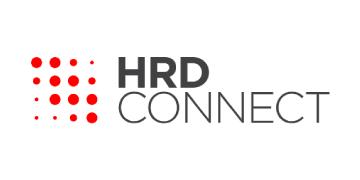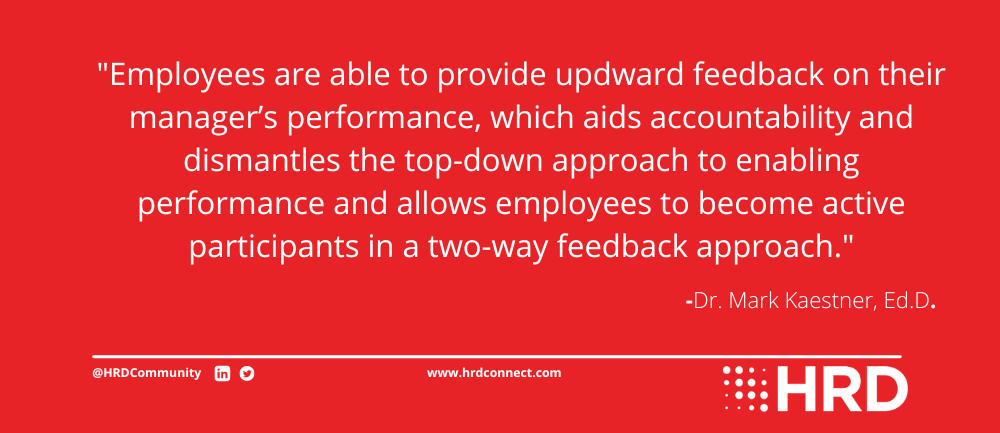-
Provided by

- Date published: Oct 18, 2022
- Categories
Dr. Mark Kaestner, Ed.D. is one of the most influential thinkers in the U.S. HR community, having been part of the team who created a new kind of performance management practice that facilitates regular communication and two-way feedback, enabling employers to address performance issues and build credibility among their teams.
Having been one of the architects who developed the continuous performance approach at The Coca-Cola Company, Mark has had the opportunity to continue to refine the approach and implement the practice within different organizations. Here, he tells HRD Connect how the model/“practice“ works – and why the strains of the post-Covid world make it more relevant than ever.
Simple and measurable
“Think about a soccer team”, Dr. Kaestner says when asked to explain the benefits of the employee review model.
“There are some players who score every game. They’re the high-performers, the ones who deliver all the time. Then there are those who score once every few matches, the ones who deliver occasionally. And then there are those who never score, the ones who never deliver. They’re the ones you’re going to want to trade.
“This simplistic analogy demonstrates a very clear metric that managers and owners can gauge. But in the business world we use terms like ‘exceeds’, ‘slight exceeds’, ‘meets’, ‘slightly meets’, and ‘does not meet’, and they’re often quite vague. What do these terms really mean?
“We need to create both clear terminologies and clear metrics, so leaders can visualize them and say ‘okay if these were the goals and objectives, did my team deliver on them? Did they consistently deliver on all the objectives, or only on some of them?’ Leaders need to be able to articulate these objectives, and people need to know where they stand.
“And it’s important that we review these objectives regularly not just once a year – priorities are fluid and the team needs to be able to adjust. So you’re allowing the person to grow, you’re investing in them, they have clarity, and there’s not this black box where the employee has to wait until the end of the year and then, all of sudden, it’s like ‘wait, I’m off-track? How did that happen?”
Simple, measurable objectives and regular one-on-one check-ins are critical. It’s a practice that the team implemented at one of the biggest corporations on the planet.
Bridging a confidence gap
Mark and the team developed the practice at The Coca-Cola Company, where he headed up the global learning function. Mark then refined and implemented the practice at Graphic Packaging International in 2019. He has just started a new role as VP, Talent Development, People Analytics and Transformation at Ball, a Denver-headquartered multinational whose operations span both packaging and aerospace.
The world of work has changed dramatically and the future of work has (quite literally) zoomed into the present, forcing companies all over the world to rethink the way they measure and review the productivity of their people.
From Mark’s point of view, however, the core tenets of managing good performance enablement remain the same: clear objectives, continuous feedback, clarity for all stakeholders, achieved through a transparent system that everyone can trust.
The world craves authenticity more than ever, but this isn’t always reflected in our workplaces; a Harvard Business Review survey, published earlier this year, found that 58% of people trust total strangers more than their own boss.
Through this modern and contemporized methodology to enable performance, Mark and the team are striving to bridge this confidence gap.
‘We were spending a huge amount of money but couldn’t see an impact’
The methodology was born out of frustration at the disconnect between the traditional performance process and business results. Mark and his colleagues found that the ‘traditional’ performance management model, built around a broad set of goals established at the start of the year and then assessed at the middle and end, did not deliver tangible ROI.
‘If you looked at a group that followed the process rigorously, they may not have achieved their results. On the other hand, a unit that didn’t follow the process, or only partially followed it, might have achieved their results.
‘We were spending an enormous amount of time and resources, which equated to a tremendous amount of money, to complete a process or check the box when actually we were unable to show an impact in the business.
‘Another significant problem was that, in cases of low performance, a significant amount of time would go by before we addressed it. Why would you wait so long?
‘Think about the practicality of the process. Let’s imagine you check in at six months, and everything’s okay at that point in time. Then you check in at 12 months, and things are a little bit off track.
‘So then you decide to course-correct and you outline a plan for the next three months. So now you’re at 15 months, and let’s say at 15 months, things improve slightly, so you say ‘okay. Let’s wait until the end of the year.’ Now you’re 24 months in and they may be off-track again.
‘You’re not addressing poor or low performance and you’re not course-correcting in real-time.’
‘You can course-correct quickly – and you’ve got loads more data points’
So Mark and his colleagues introduced a more continuous process. They continued to set goals and objectives at the beginning of the year, around the company’s objectives, but they introduced a continuous practice that repeated every month. At each one-on-one meeting, leaders would discuss the objectives for the next 45 days, giving their directs reports a specific set of short-term objectives to focus on.
‘This achieves two things,’ Mark says. ‘One, you’re having a one-on-one conversation around performance for the last 30 days. You’re reviewing your colleague’s objectives, gauging whether they’re making progress and telling them how you see their performance.
‘Your colleague knows where they stand and you can address anything that might be leading to low performance at that point in time, so you can course-correct before problems get out of hand.
‘And you’re also creating more data points. When you arrive at the formal year-end process, you now have 11 or 12 data points versus the one you’d get from mid-year.’
Accountability on both sides
But the benefits don’t stop there. As well as facilitating quicker remedies for poor performance and establishing a data-driven process that benefits all sides, the practice also encourages two-way feedback.
Employees are able to provide upward feedback on their manager’s performance, which aids accountability and dismantles the top-down approach to enabling performance and allows employees to become active participants in a two-way feedback approach. Upward feedback has been cited as a key factor in building progressive work cultures and rooting out potentially negative behaviors at management level. In the continuous feedback approach, this is pivotal.
‘The traditional approach rarely if ever allows people to give feedback on the leaders’ performance’, Mark says. ‘How could employees tell leaders whether they were effective and whether they were helping that person be the best version of themselves?’
To address this problem, the continuous approach to performance includes a quarterly review of managers by their teams, with individual employees invited to provide upward feedback around certain specific questions.
This is augmented by a process of ‘manager reflection’, leaders have the opportunity to “reflect” by answering questions about each of their employees, so they can organize their thoughts before they sit down for the one-on-one talk.
So not only is the practice measurable and rational; it ensures mutual accountability.
As Forbes noted, the new hybrid working age will be decided by lean organizations with minimal hierarchy. ‘Flatter’ organizations have greater freedom to try new ideas, and their extra agility allows them to form dynamic pop-up teams more quickly.
In a world shaped by rapid technological expansion and the consumer-driven expectations of younger workers, these benefits aren’t just ‘nice to haves’: they’re absolutely essential.

Agility is critical
Indeed, Mark thinks the changes catalyzed by Covid-19 make this approach to performance even more valuable.
‘I think the continuous approach to enabling performance helps immensely. Today, there’s an expectation that you’re having these organic one-on-one conversations more frequently, and you’re staying connected with a team that isn’t necessarily all sitting across from one another in an office.
‘One of the things we saw with the pandemic is that leaders realized that they had to have more intentionality around connecting with their team. We were all remote, and you just couldn’t walk down the hallway and drop into somebody’s office.
‘And so having this type of practice where you are intentionally meeting with each member of your team to talk about the work, where you’re at with the work and how I can support you and how you’re doing, you’re staying connected. That connectivity is easy to lose in a virtual environment.’
That doesn’t mean the approach won’t be tweaked. Agility is critical just like the approach and overtime we have made several minor adjustments to the practice; the upward feedback was originally delivered monthly, but Mark and his team reduced the frequency when they began to notice a drop-off in participation. And the number of questions fielded to managers during their reflection stage has been cut from 10 to three, to really home in on the core issues and maximize the value of each manager’s time.
This process of test-and-learn will continue. At the heart of the performance practice is the one-on-one between managers and their direct reports. Just like managers and their teams, the practice itself is under constant review. So, whatever twists and turns the “future of work” brings, the practice can course-correct. Fast.
